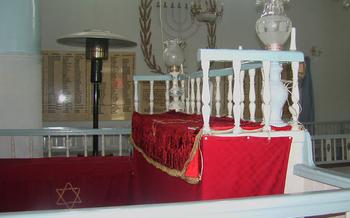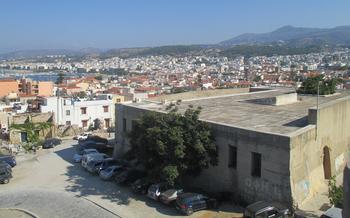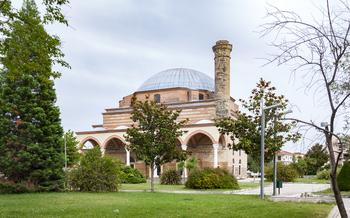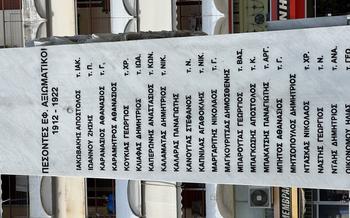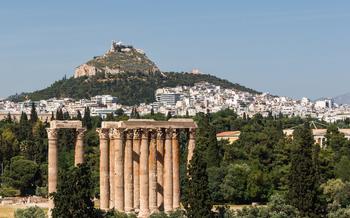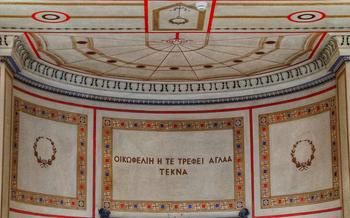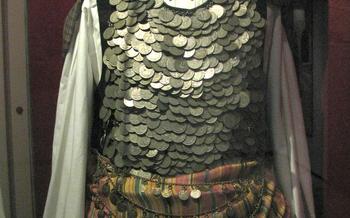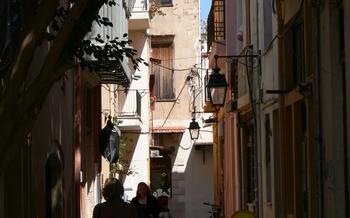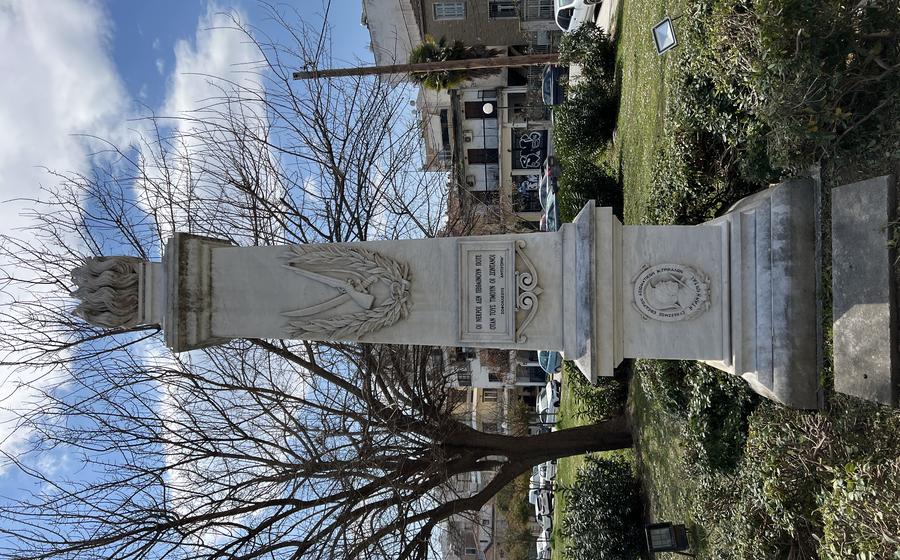
Chasiotis Folklore Museum
- Historical Background
- Location and Accessibility
- Museum Collections
- Folklore Displays
- Textile Arts
- Woodworking and Metalworking
- Pottery and Ceramics
- Traditional Music and Dance
- Educational Programs
- Guided Tours
- Souvenir Shop
- Visitor Experience
- Photography and Social Media
- Insider Tip: Unveiling the Secret Rooftop Terrace
Historical Background
The Chasiotis Folklore Museum in Trikala, Greece, is a testament to the rich cultural heritage of the region. Founded in 1982 by local businessman and philanthropist Dimitrios Chasiotis, the museum showcases a diverse collection of artifacts that offer a glimpse into the traditional way of life in Thessaly. The museum's mission is to preserve, promote, and educate visitors about the folklore, customs, and traditions of the Greek people, ensuring that these valuable aspects of their cultural identity are not lost to time.
Location and Accessibility
The Chasiotis Folklore Museum is strategically located at 5 Othona Street, in the heart of Trikala, Greece. This convenient address places it within easy reach for both locals and visitors alike. To ensure a smooth and stress-free journey, consider utilizing public transportation options. Several bus routes have stops near the museum, providing a budget-friendly and eco-conscious mode of transport. Alternatively, for those who prefer the convenience of a private vehicle, ample parking is available in the vicinity of the museum. Whether you choose to walk, take public transportation, or drive, the Chasiotis Folklore Museum is easily accessible, inviting visitors to immerse themselves in the cultural treasures it holds.
Museum Collections
The Chasiotis Folklore Museum houses a diverse collection of artifacts that offer a glimpse into the rich cultural heritage of Greece. The exhibits are carefully curated and presented, allowing visitors to explore different aspects of Greek life and traditions.
Traditional Costumes and Textiles: One of the highlights of the museum is its collection of traditional Greek costumes. These intricately embroidered garments, made from local materials such as wool and silk, showcase the skill and artistry of Greek artisans. Visitors can admire the vibrant colors, intricate designs, and unique styles that reflect different regions and periods in Greek history.
Handwoven Rugs and Carpets: The museum also displays a collection of handwoven rugs and carpets, crafted using traditional techniques passed down through generations. These textiles feature geometric patterns, floral motifs, and symbolic designs that hold cultural significance. Visitors can appreciate the meticulous craftsmanship and the vibrant colors that bring these carpets to life.
Ceramics and Pottery: The Chasiotis Folklore Museum showcases a variety of ceramic and pottery pieces, including plates, bowls, vases, and decorative objects. These items are made using local clay and traditional firing techniques. Visitors can admire the intricate designs, glazed finishes, and unique shapes that characterize Greek ceramics.
Woodworking and Metalworking: The museum also features a collection of handcrafted wooden furniture, decorative objects, and metalwork items. Visitors can appreciate the skill and precision involved in creating these pieces, which range from simple utilitarian objects to intricately carved and embellished decorative items.
Religious Artifacts: The Chasiotis Folklore Museum also houses a collection of religious artifacts, including icons, crosses, and other objects used in Greek Orthodox rituals. These artifacts provide insight into the deep religious traditions and beliefs that have shaped Greek culture.
Folklore Displays
The Chasiotis Folklore Museum houses a rich collection of folklore artifacts and displays that provide a glimpse into the traditions and customs of the local people. Visitors can explore exhibits showcasing traditional costumes, jewelry, textiles, and household items. These displays offer insights into the daily lives and cultural practices of the region's inhabitants throughout history.
The museum also features a section dedicated to traditional religious practices and rituals. Visitors can see intricate iconography, ceremonial objects, and vestments that were used in religious ceremonies and festivals. These exhibits provide an understanding of the deep spiritual beliefs and traditions that have shaped the local culture.
Beyond religious practices, the museum also showcases the region's rich storytelling tradition. Visitors can discover a collection of folk tales, legends, and myths that have been passed down through generations. These stories provide a glimpse into the imaginative world of the local people and their unique perspectives on the world.
The Folklore Displays at the Chasiotis Folklore Museum offer a comprehensive and engaging exploration of the region's cultural heritage. Through these exhibits, visitors gain a deeper understanding of the traditions, beliefs, and practices that have shaped the identity of the people of Trikala and the surrounding area.
Textile Arts
The Chasiotis Folklore Museum houses a remarkable collection of traditional textiles, showcasing the intricate embroidery and weaving techniques that have been passed down through generations in Greece. One highlight is the display of traditional costumes, meticulously crafted with vibrant colors and intricate patterns. These costumes offer a glimpse into the diverse regional styles and customs of the country.
In addition, the museum showcases a variety of handmade textiles, such as rugs, blankets, and tablecloths. These pieces demonstrate the skill and artistry of local artisans, who have preserved these traditional techniques for centuries. The museum's collection includes examples of both everyday and ceremonial textiles, providing a comprehensive overview of the role textiles have played in Greek culture and everyday life.
Woodworking and Metalworking
The Chasiotis Folklore Museum celebrates the rich tradition of woodworking and metalworking in Greece. Skilled artisans demonstrate their craftsmanship, using traditional tools and techniques to create beautiful and functional objects. Visitors can witness the transformation of raw materials into intricate pieces of furniture, decorative objects, and tools.
Among the woodworking exhibits, you'll find intricately carved furniture, decorative panels, and musical instruments. The metalworking section showcases a variety of handcrafted items, including jewelry, kitchenware, and agricultural tools. Each piece is a testament to the skill and artistry of the craftsmen who created it.
The museum also houses a collection of traditional tools and equipment used in woodworking and metalworking. These tools provide insight into the processes and techniques employed by artisans in the past. The museum's collection includes saws, chisels, hammers, and anvils, each with its own unique history and purpose.
Pottery and Ceramics
The Chasiotis Folklore Museum houses an impressive collection of handmade pottery, plates, and vases that showcase the rich ceramic tradition of the region. Visitors can admire the intricate designs and vibrant colors that adorn these pieces, which are crafted using local clay and traditional techniques passed down through generations. The museum's collection includes both decorative and functional items, offering a glimpse into the everyday lives of the people who created and used them.
One of the highlights of the pottery collection is a series of large storage jars known as pithoi. These impressive vessels were used to store grain, wine, and other provisions, and their size and durability are a testament to the skill of the potters who made them. The museum also displays a variety of smaller vessels, such as plates, bowls, and cups, which feature intricate patterns and designs that reflect the artistic sensibilities of the region.
In addition to its collection of traditional pottery, the Chasiotis Folklore Museum also showcases contemporary ceramic works by local artisans. These pieces often incorporate modern design elements while still drawing inspiration from the region's rich ceramic heritage. Visitors can admire the creativity and innovation of these contemporary artists, who are helping to keep the tradition of pottery alive in Trikala.
Traditional Music and Dance
The Chasiotis Folklore Museum is not just about static exhibits; it's also a vibrant platform for celebrating the dynamic aspects of Greek culture. Traditional music and dance are integral components of the Greek identity, and the museum brings these traditions to life through captivating performances and immersive experiences.
At the heart of the museum's performance space, visitors are treated to the soulful melodies of traditional Greek music, played by talented musicians using authentic instruments like the bouzouki, the clarinet, and the violin. The enchanting tunes transport visitors to a world of nostalgia and cultural pride.
Complementing the music is the mesmerizing spectacle of traditional Greek dance. Dancers adorned in colorful costumes showcase the grace and energy of these age-old movements. From the lively zeibekiko to the playful syrtaki, each dance tells a story of joy, sorrow, and the indomitable spirit of the Greek people.
More than just performances, the museum offers opportunities for visitors to learn and actively participate in these cultural traditions. Workshops and classes are conducted by experienced instructors, providing insights into the techniques and rhythmic patterns that define Greek dance. Whether you're a novice or an enthusiast, these sessions offer a chance to immerse yourself in the vibrant tapestry of Greek culture.
Educational Programs
The Chasiotis Folklore Museum is dedicated to preserving and promoting Greek cultural heritage through educational programs. The museum offers a variety of workshops and classes that allow visitors to learn about and experience the traditional arts and crafts of Greece. These programs are open to people of all ages and skill levels and are a great way to connect with the local culture.
One of the most popular workshops is the embroidery class, where participants learn the basics of traditional Greek embroidery techniques. The class covers everything from selecting the right materials to creating intricate designs. Participants can choose to work on a variety of projects, such as tablecloths, pillowcases, and clothing.
Another popular workshop is the weaving class, where participants learn how to use a loom to create beautiful woven goods. The class covers the different types of looms, as well as the various techniques used to create different patterns. Participants can choose to work on a variety of projects, such as rugs, blankets, and scarves.
The museum also offers a variety of other educational programs, such as lectures, demonstrations, and performances. These programs cover a wide range of topics, including Greek mythology, traditional music, and dance. The programs are a great way to learn more about Greek culture and to experience the traditions that have been passed down for generations.
Guided Tours
The Chasiotis Folklore Museum offers guided tours in various languages, including English, French, and German. These tours are led by knowledgeable and experienced guides who provide insightful explanations of the exhibits and their cultural significance. By taking a guided tour, visitors can gain a deeper understanding of the museum's collection and the rich history of Greek folklore.
The guides at the Chasiotis Folklore Museum are passionate about sharing their knowledge and enthusiasm for Greek culture with visitors. They will take you on a journey through the museum's exhibits, explaining the stories behind the artifacts and the traditions they represent. They will also point out hidden details and provide historical context, bringing the museum's collection to life.
Whether you are a history buff, a lover of traditional crafts, or simply curious about Greek culture, taking a guided tour of the Chasiotis Folklore Museum is an enriching experience that will leave you with a lasting impression.
Souvenir Shop
The Chasiotis Folklore Museum has a well-stocked souvenir shop that offers a wide range of locally made crafts and souvenirs. This is a great place to find unique gifts and mementos of your visit to Trikala. The shop sells a variety of items, including handmade pottery, woven textiles, wood carvings, and metalwork. You can also find traditional Greek costumes, jewelry, and music. All of the items are made by local artisans, and the proceeds from the sales support the museum's preservation efforts.
When you visit the souvenir shop, be sure to take your time to browse the selection. You're sure to find something special to take home with you. If you need help finding something specific, don't hesitate to ask one of the friendly staff members for assistance. They are always happy to help visitors find the perfect souvenir.
By purchasing a souvenir from the Chasiotis Folklore Museum, you are not only taking home a piece of Greek culture, but you are also helping to support the museum's important work of preserving and promoting Greek heritage.
Visitor Experience
My visit to the Chasiotis Folklore Museum was an enriching and immersive experience that transported me back in time. The museum's carefully curated exhibits, showcasing traditional crafts, costumes, and artifacts, provided a glimpse into the rich cultural heritage of Greece. The intricate embroidery, handmade textiles, and exquisite pottery left me in awe of the skill and artistry of the local craftsmen.
I was particularly fascinated by the section dedicated to traditional music and dance. The museum's collaboration with local performers allowed me to witness live demonstrations of authentic Greek dances and listen to enchanting melodies played on traditional instruments. It was a privilege to observe the passion and dedication of these performers as they brought the museum's exhibits to life.
During my visit, I had the opportunity to engage in a hands-on pottery workshop, where I learned the basics of clay molding and glazing. It was a rewarding experience that gave me a deeper appreciation for the craftsmanship involved in creating these beautiful ceramic pieces.
Overall, my time at the Chasiotis Folklore Museum was an unforgettable journey through Greek culture and traditions. The museum's interactive exhibits, engaging performances, and educational workshops made it a truly immersive and enriching experience. I left the museum with a newfound respect for the history and heritage of this beautiful country.
Photography and Social Media
Photography enthusiasts will be delighted to capture the vibrant colors and intricate details of the museum's exhibits. While taking photos is permitted, please be mindful of other visitors and refrain from using flash photography. Remember to tag the museum (@chasiotisfolkloremuseum) and use relevant hashtags (#chasiotismuseum, #greekfolklore, #trikalaculture) to share your experiences with the world. Your social media posts will not only inspire others to visit but also contribute to the museum's ongoing efforts to promote Greek heritage and traditions.
Insider Tip: Unveiling the Secret Rooftop Terrace
As you wander through the Chasiotis Folklore Museum, make sure to keep an eye out for a hidden gem—the rooftop terrace. Accessible via a discreet staircase, this tranquil oasis offers a breathtaking panorama of Trikala and its surroundings. From this vantage point, you can admire the city's terracotta rooftops, the lush greenery of the surrounding hills, and even catch a glimpse of the distant Pindus Mountains.
The rooftop terrace is the perfect place to escape the hustle and bustle of the museum and enjoy a moment of serenity. Bring a book and bask in the warm Greek sunshine, or simply relax and let the panoramic views soothe your soul. This secluded spot is also an ideal location to capture some truly Instagram-worthy shots of Trikala.
Remember to be respectful of the museum's rules and regulations when visiting the rooftop terrace. Please refrain from making excessive noise or disturbing other visitors, as it is intended to be a tranquil space for contemplation and enjoyment.
